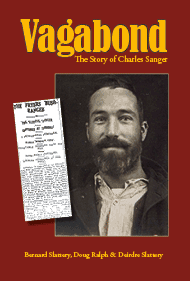
The Tale of a Bush Hermit
He was dashing, amiable and charismatic—but one thing he found it hard to bear was the company of others.
Lots of people argue about our forests, but very few Australians actually live in them.
One of the last to do so in Victoria was a dashing but baffling character named Charles Sanger, who lived as a hermit in the Fryers and Upper Loddon Forests for nearly fifty years till his death in 1953.
Sanger led a rumbustious youth, and did three terms in Pentridge before retiring to the forest in 1916.
Journalists called him the ‘Fryers Bushranger’. It was a gross exaggeration: he never threatened anyone with a gun, and though he carried an old rifle, he once assured a policeman about to arrest him, ‘It won’t go off.’
His last brush with the law involved an extraordinary struggle with a police officer in the main street of Taradale in 1914. The battle ended as a farce when Sanger’s trousers fell down, and he was overpowered as he tried to get himself in order.
Before that he had been the subject of numerous sensational stories. In the guise of a ‘semi naked madman’ he had held up police on Middleton Creek. He was questioned after someone tried to blow up a house in Kangaroo Flat; and he was wanted for the murder of an old age pensioner nearby in Sunrise Gully. In 1911 police scoured the ranges from Mount Alexander to the Fryers Ranges looking for him without success, amid rumours that he had an armoury of weapons, and was threatening to shoot any policeman who came near him.
All the serious charges against him were flimsy, and were abandoned. He served three terms in Pentridge, but for petty crimes: theft of a ham, a bicycle, a pair of boots, and other small items. He was a strange and charismatic vagabond, seen by the Bendigo Advertiser as ‘a man of fine physique, with sunburnt features and an even row of white teeth which show plainly when he smiles.’ The Mount Alexander Mail described him as ‘graceful as an antelope…a first class shot and good distance bicycle rider.’ When the police were hunting him he was supported by people in the Mount Alexander region who believed he was innocent of most of the charges levelled against him.
He lived alone in the forest for fifty years, surviving by prospecting, cultivating little gardens, and robbing honey trees. He even found time to conduct a tantalising romance and a brief marriage which could not survive his solitary bush ways.
Some said he was mad. Certainly intelligent observers remarked on his eccentric way of life and his cheerful lack of concern about the prospect of imprisonment. They dismissed madness as the problem, but tried, without success, to pin down what it was that prevented Sanger from ever adapting to ‘normal’ society.
The Sanger story is folklore in the Fryers district. The first person to put it on paper was William MacDonald, a Porcupine Ridge farmer, who wrote a brief account of Sanger’s life in the 1970s. It is remarkable how much MacDonald’s seven page typescript, based on memory and local stories, tallies with the documented facts. In trying to explore and expand on Sanger’s story, FOBIF researchers found themselves repeatedly returning to MacDonald’s version. We were intrigued by his guesswork, provoked by the occasional mistake in his version, but most of all touched by his evident sympathy for his strange subject.
The MacDonald family have been farming the Ridge near Mount Franklin since the 1850s, and the present members of the family say they can’t hear the sound of the boobook owl without remembering tales of the lonely bushman, wandering along the edge of the farms, imitating the bird as he walked. This in itself is a touching testimony to the fact that human and natural history can intersect, and the sounds of nature take on cultural meaning.
Sanger was respected and liked by those who came across him. His story is also the story of the changing bushlands of the declining gold era, and of a tolerant rural community which accepted this strange man as one of their own.
A detailed account of Sanger’s life, including a brief forest history of the Mount Alexander region, is found in Vagabond: the Story of Charles Sanger published by The Friends of the Box Ironbark Forests: RRP $15. It is available from Dymocks Bendigo, Stonemans Bookroom Castlemaine, Castlemaine Information Centre, Paradise Books Daylesford, and other outlets.
|